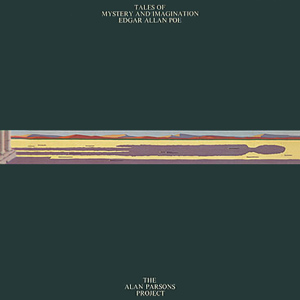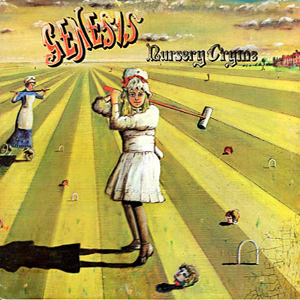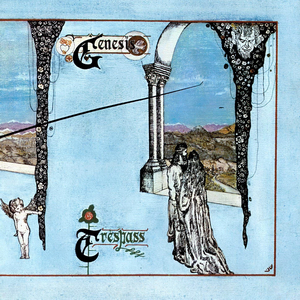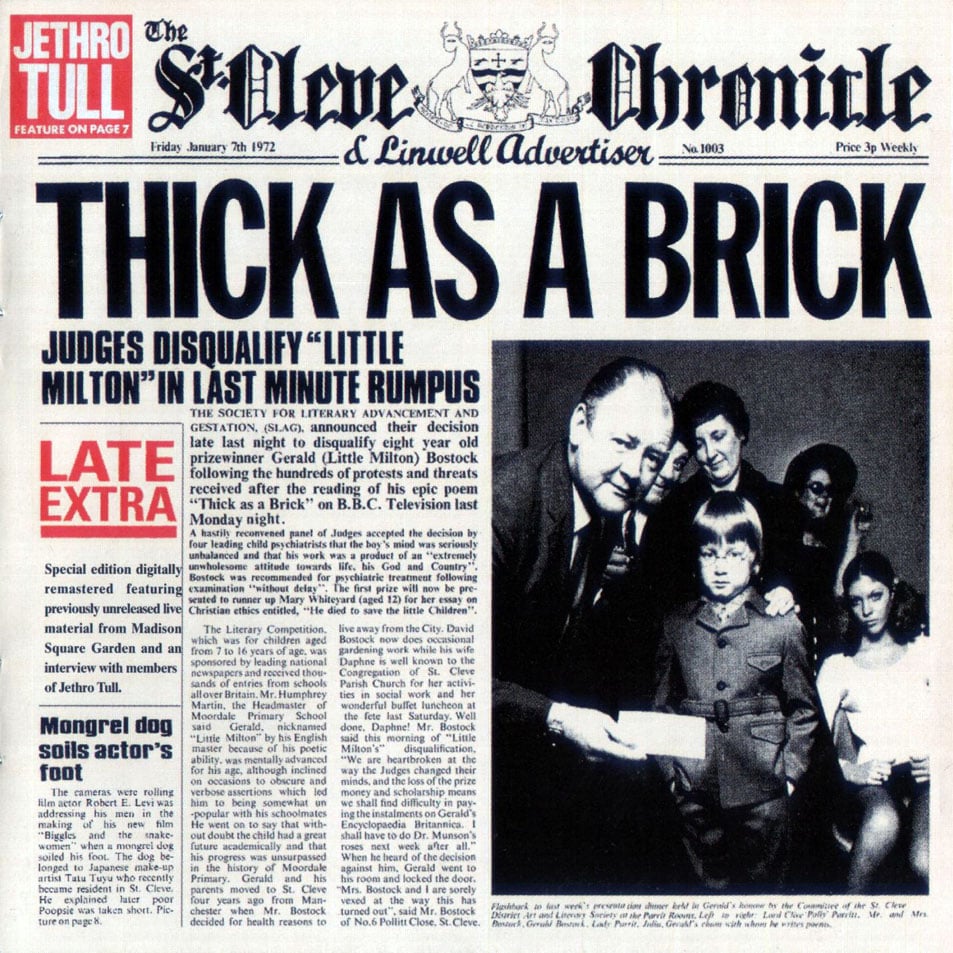This is a continuation of my last post cataloging my fave progressive rock albums of all-time. If I can editorialize for a minute, you might do some cross-referencing of these artists with those currently in the Rock & Roll Hall Of Fame. Pink Floyd and Genesis managed to sneak in, but where are the Moody Blues, Jethro Tull, Yes, Procol Harum to name a few – will they ever be elected? Don’t forget to read the first part for #50 – 26. Now on to #25 – 1:

25.Emerson Lake & Palmer – Trilogy (1972)
Their first album likely would have been #51 on my list but this is the one that grabbed me the most with it’s faux Ravel (“Abaddon’s Bolero”) and the superb cover of Copland’s “Hoedown (taken from Rodeo)” on which Keith Emerson plays some manic organ.

24.The Alan Parsons Project – Tales Of Mystery & Imagination – Edgar Allan Poe (1976/1987)
The first album from the collective helmed by producer Alan Parsons and Eric Woolfson (who never has gotten enough credit for his work). They would go on to have a strong career filled with radio-friendly hits, but at this point they were an unknown – a cast of players mostly from Ambrosia and Pilot with guest singers like John Miles (“[The System Of] Dr. Tarr & Professor Fether”). Terry Sylvester sings like an angel over a choir on “To One In Paradise” making you wish he would have taken the lead more in the Hollies more. The 1987 remix with Orson Welles spoken intros improves an already excellent album.

23.King Crimson – In The Wake Of Poseidon (1970)
Current criticism of this second KC album is that is follows a similar path to their first album. Well, frankly, that isn’t a bad thing as both albums are outstanding. After the first album, the band splintered and this record found Robert Fripp taking the reins from the departed Ian McDonald (who went on to early Foreigner). Even though he was out of the band and in ELP, Greg Lake guested on vocals except on “Cadence & Cascade”. The mellotron driven title track is the highlight for me as is the three part downright evil sounding “The Devil’s Triangle”.

22.Blackfield – Blackfield (2005)
Steven Wilson of Porcupine Tree and Aviv Geffen from Israel teamed up for an outstanding modern prog album. You hear hints of Pink Floyd and other touchstone bands but the music is catchy and original. Especially love the title track, “Scars” and “Pain” – all melancholy and midtempo.

21.Genesis – Nursery Cryme (1971)
Many early fans point to Foxtrot as their fave, but this is the one that still grabs me (thanks to my old pal and drummer Dan Campbell for turning me on to this album and so many others years ago!). “Seven Stones” is a pretty ballad but the closing “The Fountain Of Salmacis” is amazing with a story from mythology, great harmony vocals, ethereal keys and some excellent playing from new guys Steve Hackett (guitar) and a drummer we will hear from later named Phil Collins. The illustrated lyrics and a cover about a rather evil croquet game (after album track “The Musical Box”) were certainly eyecatching.

20.Triumvirat – Spartacus (1975)
Keyboardist Jurgen Fritz Germanically channels Keith Emerson (ELP) on this album with very catchy songs to boot. Have to wonder what the mouse in the lightbulb has to do with Spartacus – gotta figure a picture of battling Romans might have sold better. “The March To The Eternal City” sounds amazing on CD.

19.The Moody Blues – In Search Of The Lost Chord (1968)
The second album from the Hayward/Lodge edition of the band found them more comfortable with their ability to act as a self-contained orchestra. Graeme Edge’s billowing blasting intro leads seamlessly to Lodge’s great single “Ride My See-Saw”. The album also features the Ray Thomas tribute to LSD guru Timothy Leary “Legend Of The Mind”. Side two includes Justin Hayward’s love song “The Actor” and Mike Pinder’s spacey “The Best Way To Travel” (listen with headphones on as the sounds swirl around your head). At this point we all started to believe they were tapping in to some great cosmic truths – of course they were only singers in a rock and roll band.

18.Procol Harum – Shine On Brightly (1968)
While there were some fine individual songs on the album (notably the title track with Robin Trower’s screaming riff and more baroque organ from Matthew Fisher), it was the long side two opus “In Held Twas In I” that made us all take notice (and still does). After Keith Reid’s lyrics intone that “life is like a bean stalk, isn’t it?”, the band crashes in and the mini-symphonia is on. This set the stage for many other bands to follow suit (this stretching lengths in the studio supposedly inspired Pete Townshend to move into his own rock opera with the Who). My vote is for the U.S. green cover over the awful U.K. version.

17.Strawbs – Hero & Heroine (1974)
Featuring some of the best mellotron driven songs ever by a progressive band, what kept this album from topping this list was the horrid “Just Love” and Dave Cousins’ ill-conceived sexual lyrics at times. Too bad he didn’t write about cosmic themes instead of… well, you know. “Autumn” is simply glorious while the title track has the best use of mellotron as an aggressive lead instrument (played by John Hawken). Your’s truly managed to see them touring this album at Ebbets Field in Denver and sat so close to the stage that it was tough to keep one’s feet out of the back of the mellotron plus Cousins came by to say hi – cool.

16.Pink Floyd – Atom Heart Mother (1970)
Floyd fanatics are probably screaming at this being my fave album by them, but I love the side-long orchestrated title track (Ron Geesin gets alot of credit from me and blame by many fans). The shorter tracks are also some of my faves ever by them (“If” and especially Rick Wright’s “Summer ’68”).

15.The Moody Blues – Days Of Future Passed (1967)
With this album and Procol Harum’s first, you have the beginning of prog rock – and what great albums to be the first of a genre. The story has been told that the record company wanted the Moody’s to record a demo of Dvorak’s New World Symphony however they were more ambitious and came up with an orchestrated (by Peter Knight) masterwork with the classic songs “Nights In White Satin” and “Tuesday Afternoon” as centerpieces. My pal DC thinks they still might have time to record Dvorak – wouldn’t that be cool?

14.Family – Music In A Doll’s House (1968)
Family’s first album exists in a middle world betwixt psych and prog, but no matter the label it was a masterpiece of a debut produced by Traffic’s Dave Mason (and includes his song “Never Like This”). The production and engineering by Eddie Kramer and George Chiantz are mindblowing when heard in headphones with the lights down low. The side two suite of songs is especially disturbing with Rick Grech’s soaring violin powering “Peace Of Mind” which leads to “The Voyage” with Roger Chapman’s very strange voice to the fore over devilish sounds. That gives way to the gentle “The Breeze”. Great cover as well.

13.Genesis – Wind & Wuthering (1976)
The second post-Gabriel album found a band secure that Phil Collins could carry the lead vocal load and wow were they tight as an instrumental act as can be heard on “Unquiet Slumbers For The Sleepers…” “…In That Quiet Earth” which leads to the powerful ending track “Afterglow”. They showed a gleam of their pop future on “Your Own Special Way” which would flower into huge success on Abacab and Invisible Touch. As a live band there was no better augmented by Chester Thompson (drums) and Daryl Stuermer (guitar) and an incredible laser light show (as captured on the live Seconds Out album) – my favorite alltime concert – Macky Auditorium in Boulder. Sadly, guitarist Steve Hackett then left the band and after one more prog-ish album Genesis went for pop stardom.

12.Strawbs – Bursting At The Seams (1973)
Dave Cousins completed the transformation of Strawbs to an electric band with this album. The folkier Tony Hooper was out and rock guitarist Dave Lambert was in. Cousins came up with some wonderful music in “Flying” and the rocking “Lay Down” which pushed them in to the U.K. charts. The singalong “Part Of The Union” (a huge U.K. hit) showed where the Hudson Ford team was to head after this album when they left (putting out some fine albums on their own). The masterworks, though, are “Tears And Pavan” and especially the riff driven “Down By The Sea” with ethereal choral mellotron from Blue Weaver.

11.Barclay James Harvest – Everyone Is Everybody Else (1974)
A switch in labels to Polydor seemingly re-energized the band as they came up with one of their strongest albums featuring John Lees’ slap at violence “Child Of The Universe” and his anti-war “For No One” which demands the stereo to be cranked up a notch to better hear his searing lead over Woolly’s mellotron. Les Holroyd’s best here is “Crazy City” which sounds even better on their double live album of that era.

10.The Moody Blues – A Question Of Balance (1970)
It’s hard to think of any more exciting intro to an album than “Question” with Justin Hayward’s furious acoustic guitar strums followed by an orchestral sounding blast of noise till the whole band kicks in – an acoustic cool-down in the middle then the same kick-in at the end. Up next Mike Pinder asks the cosmic question “How Is It (We Are Here)”. The rest of the album is good if not up to the intro, but what a fantastic cover painting by Phil Travers.

9.Procol Harum – Home (1970)
Robin Trower’s driving riff rocker “Whisky Train” opens the album but from there things get decidedly darker as most of Keith Reid’s lyrics seem to deal with death. You get the Gary Brooker ballad “The Dead Man’s Story” and Trower’s nastier guitar on “About To Die”. For this album Chris Copping plays more organ than he would on the next more rockin’ Broken Barricades album which manifests on “Piggy Pig Pig” (which would have been outstanding had they omitted the silly pig noises near the end). The track that stands out is “Whaling Stories” that starts as a simple blues till a couple minutes in when it starts turning darker and the bass and piano echo an ominous riff that Trower and drummer B J Wilson build upon with Brooker shouting out over intense sound till it releases and the amazing choral ending comes in.

8.King Crimson – In The Court Of The Crimson King (1969)
Another touchstone in the growth of a style, this debut was unfortunately the only album released by this version of the band before Ian McDonald (keys) left and Greg Lake (vocals, bass) decamped to ELP (though he guested on the next album at least). Michael Giles’ drumming is outstanding and the guitar of Robert Fripp screams right from the opening “21st Century Schizoid Man”. Pete Sinfield supplied excellent lyrics for all 5 songs especially on the title track which features McDonald on mellotron and flute. The high point of the record for me was always “Epitaph”. Greg Lake may have been the best singer in progressive rock but let’s not forget he was a fine bassist as well.
7.Rare Bird – As Your Mind Flies By (1970)
Certainly an album not on too many top lists which is a pity as it was brilliant and a huge leap up from their first fine album. “I’m Thinking” starts with Graham Fields’ churchy organ playing a riff that the rest of the band picks up and embellishes on. Again the vocal from Steve Gould may be too powerful for some tastes but the music is baroque and lovely as on “Down On The Floor” plus you get a powerful nasty riff rocker in “Hammerhead”. Side two was taken up with the title track and honestly the music is amazing and could fit well with Pink Floyd’s Atom Heart Mother or Focus’ Moving Waves sidelong pieces. Again, double keyboards with David Kaffinetti on electric piano (later in Spinal Tap) along with Field. The U.S. album cover was far better than the dull U.K. one.

6.Jethro Tull – Aqualung (1971)
After several great bluesy/folky albums, Ian Anderson and company put it all together on this tour-de-force that he insisted wasn’t a concept album though the lyrics were disturbing and interesting (the title track about a homeless lecher and “My God” – a slap at organized religion – to name a couple). John Evan’s mellotron and Anderson’s flute intro to “Cross-Eyed Mary” is as prog as you can get till Martin Barre’s nasty guitar comes in to take it more mainstream. Check out the great riff of “Locomotive Breath” that follows a long bluesy workout. “Mother Goose” could be a track by fellow Chrysalis label Brit-folk band Steeleye Span. There would be far more Tull in this list as I love their music, but it simply doesn’t seem to work to call their other albums prog (A Passion Play might fit but how to categorize the rest? – that won’t stop me from recommending Stand Up, Benefit, Living In The Past, Songs From The Wood, etc).

5.Procol Harum – Grand Hotel (1973)
Their first Chrysalis label album in the U.S. that delivered on all fronts – great music, fine cover and a booklet to boot. Having just tasted success with their live album (and a hit in “Conquistador”), they lost Dave Ball on guitar so Mick Grabham was an unknown. He more than filled the guitar vacancy (listen to “Bringing Home The Bacon” which has some fine B J Wilson drum/cowbell work). The lovely “Fires (Which Burnt Brightly)” has a very unique vocal from Christianne Legrand of the Swingle Singers singing a solo line as opposed to a duet with Gary Brooker. The title track is simply a masterpiece of band and producer meshing and has one of Brooker’s best vocals singing Keith Reid’s words over orchestra and chorus.

4.Barclay James Harvest – Gone To Earth (1977)
A great album from beginning (John Lees’ lovely “Hymn”) to end (Les Holroyd’s harmonious “Taking My Higher”). “Spirit On The Water” is an anti-fur song with a catchy riff while Woolly’s “Sea Of Tranquility” speaks to the futility of the space race. Lees could write a song with a powerful riff like “Leper’s Song” or the gentle “Love Is Like A Violin”. The high point of the album is “Poor Man’s Moody Blues” which is how many reviewers referred to BJH so Lees wrote the greatest mellotron Moody’s sound-alike ever. A gorgeous cover as well.

3.Genesis – A Trick Of The Tail (1976)
Hard to explain what a pleasant shock it was to pick this first post-Peter Gabriel album up at the store and play it to find that if anything the band sounded better with the drummer singing – at the time we all felt he sorta sounded like Gabriel though of course now we know he just sounds like Phil Collins. There simply isn’t a weak cut here with excellent mellotron and guitar interplay. “Ripples” and “Entangled” are gentle ballads while “Dance On A Volcano” and “Squonk” show the old power they could summon. The title track showed a knack for a catchy song that would flower over the years. A nice cover and decent lyrics.

2.Strawbs – Grave New World (1972)
For those of us who bought albums based on the cover, this one certainly pulled us in with a great logo atop a William Blake nude and, upon opening, another striking painting inside. A lavish book of lyrics was also included – it simply looked classy. From the opening “Benedictus” you were in the presence of greatness – a song I want played at my memorial service. Dave Cousins sings a litany from the I Ching (“bless the daytime, bless the night, bless the sun which gives us light”) over a dulcimer driven song (fuzz dulicimer? who knew you could do that) that gives way to some wonderful piano/mellotron work by new keyboard player Blue Weaver who made up for the loss of Rick Wakeman. The folkier Tony Hooper was still in the band so the sound was more acoustic than when Dave Lambert joined but the sound can still be nasty as on the acid attack at the departed Wakeman “Tomorrow”. John Ford’s “Heavy Disguise” and Hooper’s “Ah Me, Ah My” have some excellent horn work making the former sound baroque and the latter cartoonish. “New World” is amazing with dueling minor key acoustics washed with crashing mellotron cords with some excellent Cousins lyrics that he sings with increasing passion as the song progresses. The only misstep for me is Richard Hudson’s sitar song “Is It Today, Lord?” which wasn’t a bad song, but suffered from a poor choice of backing instrumentation. The gentle piano of “The Journey’s End” closes the album admirably.

1.The Moody Blues – To Our Children’s Children’s Children (1969)
Not only the best progressive album of all-time, but arguably my favorite album of any style ever. I have seen that the theme of the album was inspired by the moon landing, but I have always seen it more globally as their ode to the Earth (“I Never Thought I’d Live To Be A Hundred” giving way later to “I Never Thought I’d Live To Be A Million”). The best Ray Thomas song ever is his “Eternity Road” (“travelling eternity road, what will you find there?”) which has some subtle playing by the band that leads to perhaps the best John Lodge composition ever “Candle Of Life”. A chilling mellotron line by Mike Pinder with excellent classic piano playing and beautifully melancholy lyrics (“something you can’t hide says you’re lonely …. burn slowly the candle of life”). If that doesn’t choke you up, the closing Justin Hayward/Ray Thomas masterpiece “Watching And Waiting” will definitely do the trick (keep your hankies handy – “watching and waiting for a friend to play with, why have I been alone so long?”). Graeme Edge’s opener “Higher And Higher” is a thrilling start and he plays excellent drums throughout the album as well (always loved the crashing cymbal rhythm on the end section of Pinder’s “Sun Is Still Shining”). The inside picture of the band huddled around a fire in a cave with a jagged vista visible through the entrance would have made a better external shot.











.jpg/220px-From_the_Witchwood_(Strawbs_album_-_cover_art).jpg)













